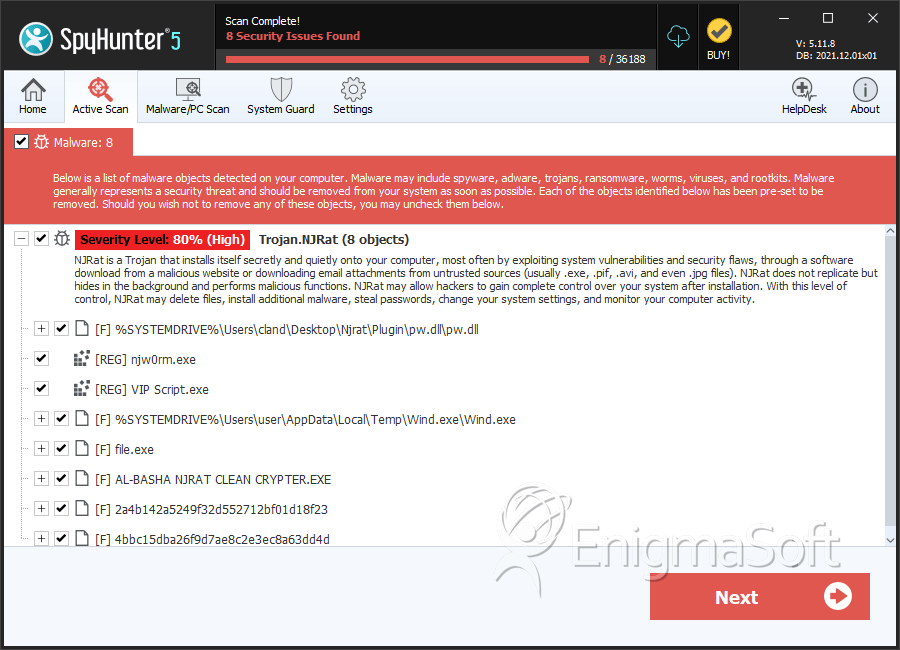Trojan.NJRat
Threat Scorecard
EnigmaSoft Threat Scorecard
EnigmaSoft Threat Scorecards are assessment reports for different malware threats which have been collected and analyzed by our research team. EnigmaSoft Threat Scorecards evaluate and rank threats using several metrics including real-world and potential risk factors, trends, frequency, prevalence, and persistence. EnigmaSoft Threat Scorecards are updated regularly based on our research data and metrics and are useful for a wide range of computer users, from end users seeking solutions to remove malware from their systems to security experts analyzing threats.
EnigmaSoft Threat Scorecards display a variety of useful information, including:
Ranking: The ranking of a particular threat in EnigmaSoft’s Threat Database.
Severity Level: The determined severity level of an object, represented numerically, based on our risk modeling process and research, as explained in our Threat Assessment Criteria.
Infected Computers: The number of confirmed and suspected cases of a particular threat detected on infected computers as reported by SpyHunter.
See also Threat Assessment Criteria.
| Ranking: | 3,438 |
| Threat Level: | 80 % (High) |
| Infected Computers: | 6,973 |
| First Seen: | August 12, 2016 |
| Last Seen: | October 19, 2024 |
| OS(es) Affected: | Windows |
NJRat is a Trojan horse application that falls under the category of a Remote Access Trojan/Remote Administration Tool (RAT), which are threats known to load on a system without any indication to the computer user where it may allow remote attackers to gain access to the infected system.
The actions of NJRat are similar to that of popular Trojan horses where it could collect data from the infected computer, which may include usernames, passwords, system details, and other information that may be personal to the computer user. Such data that is collected by NJRat may be accessed by remote hackers, which could then lead to cases of identity theft.
One of the more discerning aspects of NJRat is that it could download other malicious programs on the infected computer, which include ransomware-type threats or other unknown malware that perform malevolent activates over the Internet.
Fundamentally, malicious actions of Trojan.NJRat vary and are all in an attempt to wreak havoc on a computer and potentially steal personal information.
Table of Contents
How does NJRat end up on your computer?
The installation of NJRat may take place through spam campaigns that spread spam messages that contain malicious file attachments. Many of the file attachments may be in the form of MS office documents, PDF files, ZIP files, and even executables that appear to be harmless to most computer users. Avoiding the installation of NJRat may be as simple as paying special attention to attachment files or avoid potentially malicious sites that may offer downloaded third-party apps.
The removal of NJRat is a difficult task in most cases for even the savvy computer user. Due to NJRat having stealth-like advantages over other malware threats, it may not be easy to identify the threat and delete it from a Windows PC. Using an antimalware resource will suffice to safely detect and eliminate NJRat along with any of its associated malware files on an infected system.
SpyHunter Detects & Remove Trojan.NJRat

File System Details
| # | File Name | MD5 |
Detections
Detections: The number of confirmed and suspected cases of a particular threat detected on
infected computers as reported by SpyHunter.
|
|---|---|---|---|
| 1. | pw.dll | db87daf76c15f3808cec149f639aa64f | 856 |
| 2. | Mono.Cecil.dll | 851ec9d84343fbd089520d420348a902 | 198 |
| 3. | Wind.exe | 53a9de48e432d5587bb93bc5a8c7bb8b | 1 |
| 4. | file.exe | a78b8d72a78767f92e9d93cdc995d9ae | 0 |
| 5. | file.exe | cd312c275495e39ca7d9b186e146dd62 | 0 |
| 6. | file.exe | 1e6e5b00496d3c6629568fef18ceb5a0 | 0 |
| 7. | file.exe | c4ad44a1718771aaf94670d07652c5dd | 0 |
| 8. | file.exe | de08894d497e63ef412a144274166ea4 | 0 |
| 9. | AL-BASHA NJRAT CLEAN CRYPTER.EXE | 98ff2a318c13d486f34f81459f9d5fc8 | 0 |
| 10. | 2a4b142a5249f32d552712bf01d18f23 | 2a4b142a5249f32d552712bf01d18f23 | 0 |
| 11. | 4bbc15dba26f9d7ae8c2e3ec8a63dd4d | 4bbc15dba26f9d7ae8c2e3ec8a63dd4d | 0 |
| 12. | file.exe | 69453f86115bf0ad1c718e5ec9253a70 | 0 |
| 13. | file.exe | a9f81658b17624154c7936935b3bb6b1 | 0 |
